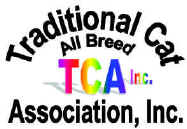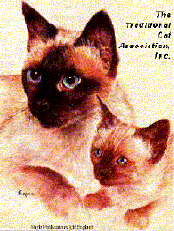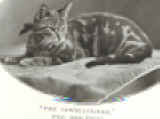
 The
Traditional Cat Association,
Inc.©1987®TM
Official Website
The
Traditional Cat Association,
Inc.©1987®TM
Official Website
Founded 1987, by Diana L.
Fineran
|
" Home of the Traditional Cat"© |
|
Our Motto: To Preserve,
Protect, Perpetuate, and Promote Traditional Cats.© |
|
|
||||||||||
|
|
|
|
Click on picture |
Q: What is the history of the Traditional American Shorthair?
A: These America's darlings are so near and dear to my heart because I grew up with them on our Dairy Farm in northern Wisconsin. Representatives of this "American Style" breed grace my home today. They are the epitome of appeal, who's sturdy, hardy, robust form, and vigor reflect natures sound design. Often used as a comparison breed for other breeds, The American Shorthair appeals to the common perception of cat-ness.
Where did they come from? There is no document memorializing their beginnings in America, yet they certainly are an American purebred breed. Through selective breeding with established bloodlines, they produce uniform offspring. With North America having no indigenous cat species in the early years, it is assumed the American Shorthair arrived with the colonists after sailing across the Atlantic Ocean. Cats were recorded in Jamestown, the first British colony in America, in 1609.
They were valuable members of society and master mousers in the barns, fields, and homes of colonial America. No intentional breeding program was conducted, so function was far more important than form. Enduring the rigors of climate and primitive lifestyles contributed to the cat's development of powerful muscles, strong jaws and a hardy constitution, through natural selection.
Our forefathers made no fuss about colors, patterns or body styles. As frontier life became easier they turned more attention toward the companionship and beauty of their feline friends. Cat shows began to be held and the American Shorthair was there to share honors with the Maine Coon. The first registered American Shorthair was an orange tabby male named, Belle Of Bradford. He came as an import from England in the 1900's. In 1904 the first American born American Shorthair, Buster Brown, was registered.
Frances Simpson mentions the American Shorthair in her 1903 book, The Book of the Cat, "In America I observe that a class is still specially reserved for orange and white cats, and it would seem that this is rather a favorite breed with our cousins over the water. In America short hairs have not "taken on", and at the various shows the specials offered are as small in number as the entries made. I never hear of any exportations of British cats to American fanciers, but perhaps some enthusiast of the breed will start a short haired cattery. There is certainly room for such an enterprise, and the sturdier Britisher would more easily resist the trials of an Atlantic trip and the terrors of a three days' show. The common or garden puss needs a kindly hand to assist in drawing him to the front, for, as that well known lover of "the domestic cat" , Harrison Weir, writes, "Why should not the cat that sits purring in front of us before the fire be an object of interest, and be selected for its color, markings, and form?"
In the same book Mr. H.E. Jung states, "It is a matter of regret that this variety at shows is not so fully represented as it should be, taking into consideration the large number of cat exhibitors. There is no doubt that the prettier long-haired variety secures greater support from the lady exhibitors. In addition to the characteristic of being a native production of the British Isles, they have certainly a great advantage in their racy, workmanlike appearance, which is lacking in the long-haired variety. I myself think there has been a great improvement in the specimens penned the last few years. The fault we must guard against is the loss of size and stamina, which can only be averted by judicious mating. The increasing number of shows in America, the Colonies, and even on the continent, should stimulate breeders of the short-haired variety to extend their catteries, for no doubt in a few years there will be a strong demand for the English-bred, short-haired cat. I would here remark upon the absence of men who take up breeding cats as a hobby, and yet the short-haired variety is essentially a man's bread. They require very little grooming and attention compared to the long-haired varieties."
Very early on in America the blooming cat fancy focused its attention and interest on perceived exotics, the Persian, Siamese and Angora imports. American Shorthairs were often not even provided cages at shows, because it had gong our of vogue. To preserve the natural beauty, mild temperament and hardiness of the American Shorthair a group of people began a selective breeding program in the early 1900's.
Sadly in the 1950's this pure breed was contaminated due to breeders deliberately crossing Persians with American Shorthairs, creating a body style more closely resembling the Persian. True blue breeders of purebred American Shorthairs were taken aback by this cross breeding, because they had struggled to preserve their natural beauty for many years. They didn't want their efforts to be thwarted by pseudo-Persians. However, these hybrids did evolve into the Exotic Shorthair breed we know today.
Q: What is the personality of the American Shorthair?
A: The expression "all things in moderation" applies to this breed. They are neither a lazy doorstop nor a hyperactive animal. They're, affectionate, sociable, loving, devoted, loyal and fun to have around. Even though they relish their independence, they generally prefer to cuddle only when it's their idea. They dislike being held, but do enjoy following you from room to room and sitting beside you rather than in your lap. Lovers of play, they tend to stay active and frisky well into old age. Water fascinates them, so don't be surprised when they hop into the sink to investigate the drips. They are very easily trained. They rarely "talk", but when they do, their voices are soft and pleasing. Usually they are peaceful and quiet.
A life span of between 15 to 20 years is not unusual, because typically they are very healthy.
HISTORICAL RECORD © March
2002
Diana Fineran
|
Click on photo to enlarge |
This 1902 photos is of great importance because it presents the breed as it originally became known and as TCA, INC. recognizes them now.
Copyright, Diana Fineran June 21, 2000
|
The Traditional Cat Association, Inc.©1987®TM ALL RIGHTS RESERVED © by John & Diana Fineran - Aug 1999- 2025 No portion of this website or any information contained within it may be copied, or in any way distributed, without the expressed written permission of John or Diana Fineran - No exceptions. |


